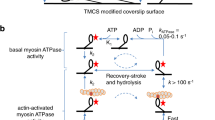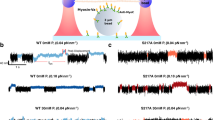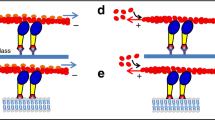Abstract
In muscle, the myosin head (‘crossbridge’) performs the ‘working stroke’, in which ATP is hydrolysed to generate the sliding of actin and myosin filaments. The myosin head consists of a globular motor domain and a long lever-arm domain. The ‘lever-arm hypothesis’1,2,3,4,5 predicts that during the working stroke, the lever-arm domain tilts against the motor domain, which is bound to actin in a fixed orientation. To detect this working stroke in operation, we constructed fusion proteins by connecting Aequorea victoria green fluorescent protein and blue fluorescent protein6,7,8 to the amino and carboxyl termini of the motor domain of myosin II of Dictyostelium discoideum, a soil amoeba, and measured the fluorescence resonance energy transfer between the two fluorescent proteins. We show here that the carboxy-terminal fluorophore swings at the isomerization step of the ATP hydrolysis cycle, and then swings back at the subsequent step in which inorganic phosphate is released, thereby mimicking the swing of the lever arm. The swing at the phosphate-release step may correspond to the working stroke, and the swing at the isomerization step to the recovery stroke.
This is a preview of subscription content, access via your institution
Access options
Subscribe to this journal
Receive 51 print issues and online access
$199.00 per year
only $3.90 per issue
Buy this article
- Purchase on Springer Link
- Instant access to full article PDF
Prices may be subject to local taxes which are calculated during checkout




Similar content being viewed by others
References
Cooke, R. The mechanism of muscle contraction. CRC Crit. Rev. Biochem. 21, 53–118 (1986).
Rayment, I. et al. Structure of the actin-myosin complex and its implications for muscle contraction. Science 261, 58–65 (1993).
Rayment, I. et al. Three-dimensional structure of myosin subfragment-1: a molecular motor. Science 261, 50–58 (1993).
Spudich, J. A. How molecular motors work. Nature 372, 515–518 (1994).
Holmes, K. C. The swinging lever-arm hypothesis of muscle contraction. Curr. Biol. 7, 112–118 (1997).
Prasher, D. C., Eckenrode, V. K., Ward, W. W., Prendergast, F. G. & Cormier, M. J. Primary structure of the Aequorea victoria green-fluorescent protein. Gene 111, 229–233 (1992).
Heim, R. & Tsien, R. Y. Engineering green fluorescent protein for improved brightness, longer wavelengths and fluorescence resonance energy transfer. Curr. Biol. 6, 178–182 (1996).
Miyawaki, A. et al. Fluorescent indicators for Ca2+ based on green fluorescent proteins and calmodulin. Nature 388, 882–887 (1997).
Warrick, H. M., DeLozanne, A., Leinwand, L. A. & Spudich, J. A. Conserved protein domains in a myosin heavy chain gene from Dictyostelium discoideum. Proc. Natl Acad. Sci. USA 83, 9433–9437 (1986).
Itakura, S. et al. Force-generating domain of myosin motor. Biochem. Biophys. Res. Commun. 196, 1504–1510 (1993).
Gulick, A. M., Bauer, C. B., Thoden, J. B. & Rayment, I. X-ray structures of the MgADP, MgATPγS, and MgAMPPNP complexes of the Dictyostelium discoideum myosin motor domain. Biochemistry 36, 11619–11628 (1997).
Smith, C. A. & Rayment, I. X-ray structure of te magnesium(II).ADP.vanadate complex of the Dictyostelium discoideum myosin motor domain to 1.2 Å resolution. Biochemistry 35, 5404–5417 (1996).
Fisher, A. J. et al. X-ray structures of the myosin motor domain of Dictyostelium discoideum complexed with MgADP.BeFxand MgADP.AlF4. Biochemistry 34, 8960–8972 (1995).
Lymn, R. W. & Taylor, E. W. Mechanism of adenosine triphosphate hydrolysis of actomyosin. Biochemistry 10, 4617–4624 (1971).
Bagshaw, C. R. & Trentham, D. R. The characterization of myosin-product complexes and of product-release steps during the magnesium ion-dependent adenosine triphosphatase reaction. Biochem. J. 141, 331–349 (1974).
Sasaki, N., Shimada, T. & Sutoh, K. Mutational analysis of the switch II loop of Dictyostelium myosin II. J. Biol. Chem. 273, 20334–20340 (1998).
Kuhlman, P. A. & Bagshaw, C. R. ATPase kinetics of the Dictyostelium discoideum myosin II motor domain. J. Muscle. Res. Cell. Motil. 19, 491–504 (1998).
Werber, M. M., Peyser, Y. M. & Muhlrad, A. Characterization of stable beryllium fluoride, aluminum fluoride, and vanadate containing myosin subfragment 1-nucleotide complexes. Biochemistry 31, 7190–7197 (1992).
Maruta, S., Henry, G. D., Sykes, B. D. & Ikebe, M. Formation of the stable myosin–ADP–aluminum fluoride and myosin–ADP–beryllium fluoride complexes and their analysis using 19F NMR. J. Biol. Chem. 268, 7093–7100 (1993).
Ormo, M. et al. Crystal structure of the Aequorea victoria green fluorescent protein. Science 273, 1392–1395 (1996).
Shimada, T., Sasaki, N., Ohkura, R. & Sutoh, K. Alanine scanning mutagenesis of the switch I region in the ATPase site of Dictyostelium discoideum myosin II. Biochemistry 36, 14037–14043 (1997).
Clegg, R. M. Fluorescence resonance energy transfer and nucleic acids. Methods Enzymol. 211, 353–388 (1992).
Stryer, L. Fluorescence energy transfer as a spectroscopic ruler. Annu. Rev. Biochem. 47, 819–846 (1978).
Miki, M. Detection of conformational changes in actin by fluorescence resonance energy transfer between tyrosine-69 and cysteine-374. Biochemistry 30, 10878–10884 (1991).
Yasunaga, T. & Wakabayashi, T. Extensible and object-oriented system Eos supplies a new environment for image analysis of electron micrographs of macromolecules. J. Struct. Biol. 116, 155–160 (1996).
Jones, T. A., Zou, J. Y., Cowan, S. W. & Kjeldgaard, M. Improved methods for building protein models in electron density maps and the location of errors in these models. Acta Crystallogr. A 47, 110–119 (1991).
Acknowledgements
We thank K. Oiwa for Cy3 nucleotides, M. Miki for discussions about the FRET experiments, and M. Steward, C.Bagshaw and P. Kuhlman for critically reading the manuscript.
Author information
Authors and Affiliations
Corresponding author
Rights and permissions
About this article
Cite this article
Suzuki, Y., Yasunaga, T., Ohkura, R. et al. Swing of the lever arm of a myosin motor at the isomerization and phosphate-release steps. Nature 396, 380–383 (1998). https://doi.org/10.1038/24640
Received:
Accepted:
Issue Date:
DOI: https://doi.org/10.1038/24640
This article is cited by
-
Cy3-ATP labeling of unfixed, permeabilized mouse hair cells
Scientific Reports (2021)
-
Temperature effect on the chemomechanical regulation of substeps within the power stroke of a single Myosin II
Scientific Reports (2016)
Comments
By submitting a comment you agree to abide by our Terms and Community Guidelines. If you find something abusive or that does not comply with our terms or guidelines please flag it as inappropriate.



